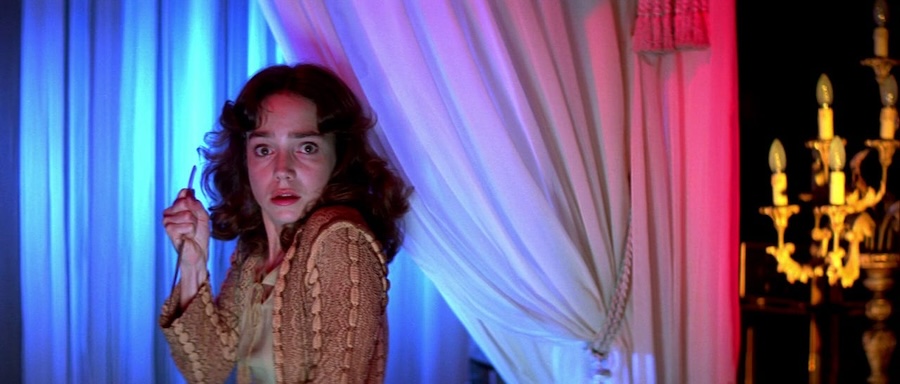
ONCE YOU’VE SEEN IT, YOU WILL NEVER AGAIN FEEL SAFE IN THE DARK.

When Dario Argento came up with the idea for his most famous film, he was traveling through Europe. The journey reinforced his interest in the occult and he had been reading Thomas de Quincey’s famous collection of essays ”Suspiria de Profundis”, published in 1845. In one of them, de Quincey imagines three companions for Levana, the Roman goddess of childbirth. Known as ”mothers”, they became symbols of covens in three of the Italian filmmaker’s horror movies. In Suspiria and some of his other films (notably Phenomena (1985)), Argento shows a knack for presenting the heart of Europe as filled with hidden supernatural wickedness.
Arriving at a dance academy
On a very rainy and stormy night, American Suzy Bannion (Jessica Harper) flies to Munich and catches a cab that takes her to a dance academy in Freiburg where she will study. When Suzy arrives, she sees another, distressed girl leave the school in haste and someone tells her over the intercom to go away. Puzzled, she returns to the city over the night. When Suzy goes back to the academy the following day, she’s welcomed by the instructor, Miss Tanner (Alida Valli), who is surprised to hear about her experiences. Suzy is introduced to other students and when she’s kicked out of the apartment she was renting in town she also moves in at the academy.
After falling ill, she’s prescribed a daily glass of wine by the resident physician. But all does not seem to be well at the academy…
Eclectic bunch of actors
The point in Europe where France, Germany and Switzerland meet has been called a triangle, and Argento seemed to be reading something mysterious and occult into that. Suspiria is indeed a colorful mixture of different nationalities, with an American lead; an old Hollywood star (Joan Bennett) in her last role as the matriarch in charge of the academy; a German actor (Udo Kier) with a cult reputation; and an Italian actress (Alida Valli), who was born a baroness, in the part of the instructor who has a look of either insanity or fanaticism in her eyes. Valli does indeed deliver the most entertaining performance of this eclectic bunch, reminding me a little bit of Cloris Leachman’s crazed Nurse Diesel in Mel Brooks’s Hitchcock parody High Anxiety, released the same year.
Shooting the film in a studio in Rome gave the filmmakers complete control of the gorgeous visual look.
The story, following Suzy’s eventual discovery of a coven at the school, is simple, but the way Argento fuses his supernatural ingredients with giallo tropes (for a movie about witches, there’s a lot of stalking and stabbing going on) is incredibly stylish. The director reportedly based the look of the film, with very bright colors (especially red and green), on old Technicolor movies from Hollywood’s golden era. Shooting the film in a studio in Rome gave the filmmakers complete control of the gorgeous visual look, but the façade of the academy (borrowed from the 16th-century Whale House in Freiburg) is also a perfect fit for the movie.
Sound plays an equally important role, with effects that add to the creepy impression of the academy and its many secrets. Argento also collaborated with the prog-rock band Goblin to create a soundtrack that primarily relies on a simple but highly effective main theme; it’s eerie and childlike yet raw, capturing the paganism of witchcraft.
Suspiria 1977-Italy. 98 min. Color. Widescreen. Directed and narrated by Dario Argento. Screenplay: Dario Argento, Daria Nicolodi. Cinematography: Luciano Tovoli. Music: Dario Argento, Goblin. Cast: Jessica Harper (Suzy Bannion), Stefania Casini (Sara), Joan Bennett (Madame Blanc), Alida Valli, Flavio Bucci, Udo Kier.
Trivia: Followed by two sequels, starting with Inferno (1980); remade as Suspiria (2018).
Last word: “I like working with women, I have always been fascinated by them. When I was very young I went to a school close to my mother’s studio; she was a photographer, famous for her portraits of actresses in the 1940s and 50s. After school, I would run there and sit in the front room where the actresses would do their make-up and get changed into glamorous dresses, and I would see these marvellous women transform. I would watch how my mother lit their faces and bodies, and when I was shooting Suspiria I remembered this.” (Argento, Another Man)
